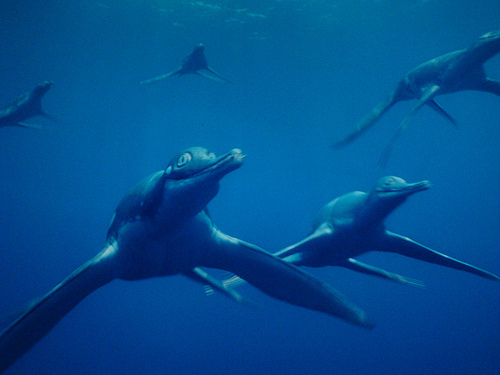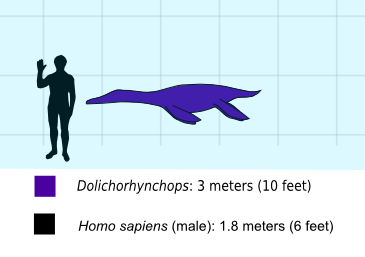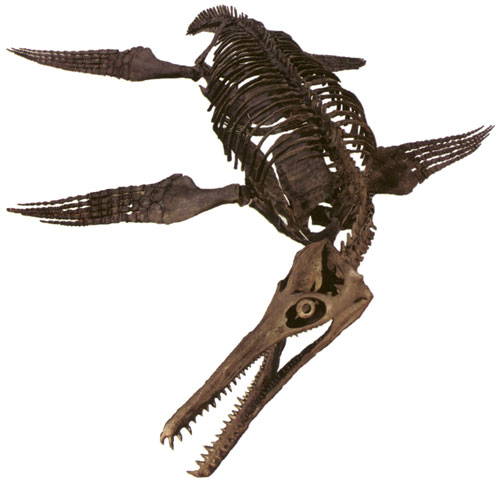[Recent Entries][Archive][Friends][User Info]
| Time | Text |
|---|---|
| 01:53 pm [Link] |
Dolichorhynchops Dolichorhynchops is an extinct genus of polycotylid plesiosaur from the Late Cretaceous (early Turonian to late Campanian stage) of North America, containing three species, D. osborni, D. herschelensis and D. tropicensis. Dolichorhynchops was an oceangoing prehistoric reptile. Its Greek generic name means "long-nosed eye," perhaps because its eyes seem placed rather far forward on its lengthy snout. The holotype specimen of Dolichorhynchops osborni was discovered in the upper Smoky Hill Chalk Logan County, Kansas, by George F. Sternberg, as a teenager, in around 1900. The remains were collected by him and his father, Charles H. Sternberg, and then sold to the University of Kansas (Lawrence, Kansas). KUVP 1300 was prepared and mounted by H.T. Martin under the supervision of Dr. Samuel Wendell Williston, who described and named it in 1902. A more detailed description and photographs were provided by Williston 1903). The specimen has been on display in the KU Museum of Natural History since that time. In 1918, Charles H. Sternberg found a large mosasaur, Tylosaurus, with the remains of a plesiosaur in its stomach. The mosasaur specimen is currently mounted in the United States National Museum (Smithsonian) and the plesiosaur remains are stored in the collections. Although these important specimens were briefly reported by Sternberg 1922, the information was lost to science until 2001. This specimen was rediscovered and described by Everhart 2004a. It is the basis for the story line in the 2007 National Geographic IMAX documentary Sea Monsters: A Prehistoric Adventure, and a book by the same name Everhart 2007. George Sternberg found a second, less complete specimen of D.osborni in 1926. In his effort to sell the specimen to a museum, Sternberg took detailed photographs of the skull. The specimen was eventually mounted in plaster and was acquired by the Harvard Museum of Comparative Zoology. MCZ 1064 was on display there until some time in the 1950s. This specimen was never completely described although the skull was figured by O'Keefe 2004. (See also Everhart 2004b) The specimen of D. osborni on exhibit at the Sternberg, FHSM VP-404 was found by Marion Bonner near Russell Springs in Logan County in the early 1950s. It is, perhaps, the most complete specimen of this species known. It is just under 10 feet in length. The skull was crushed flat but is in very good condition. This specimen was initially reported by Sternberg & Walker 1957, and then was the subject of a Masters thesis by Orville Bonner 1964. Note that it was described by Bonner as "Trinacromerum osborni" which was the accepted genus name at the time. Two very large specimens of a polycotylid plesiosaur (KUVP 40001 and 40002) were collected from the Pierre Shale of Wyoming and later reported on by Adams in her 1977 Masters thesis. Later (1997), she officially described (1997) as a new species of Trinacromerum (T. bonneri). Unknown to her at the time, Carpenter (1996) had revised the Polycotylidae and separated Dolichorhynchops from Trinacromerum. Thus the species would revert to Dolichorhynchops bonneri, but there is some question as to whether or not the specimens represent a separate species or just larger individuals of D. osborni. The question has yet to be resolved. Until recently, all known specimens of D. osborni in Kansas had been collected from the upper layers of the Smoky Hill Chalk (Campanian age). Everhart 2003 reported the first remains from the lower chalk (Late Coniacian-Santonian in age). In 2005, the remains of the earliest known D. osborni were discovered in the Fort Hays Limestone, Niobrara Formation in Jewell County, Kansas. This is the first record of a polycotylid plesiosaur in this formation. D. herschelensis was described as a new species by Tamaki Sato in 2005. It was discovered in the Bearpaw Formation of Saskatchewan, Canada, a Late Cretaceous (late Campanian to Maastrichtian) rock formation. The fossil was found close to the town of Herschel in south-western Saskatchewan, from which the species name is derived. The rock formation it was found in consists of sandstones, mudstones and shales laid down in the Western Interior Seaway, just before it began to revert to dry land. The type specimen of D. herschelensis was discovered in a disarticulated state (i.e. the bones were scattered about the discovery site). The skull, lower jaw, ribs, pelvis and shoulder blades were all recovered, but the spine was incomplete, so the exact number of vertebrae the living animal would have had is unknown. All four limbs are missing, with the exception of 9 small Phalanges (finger bones) and a small number of limb bones found close by which may belong to the animal in question. The specimen is believed to be an adult, due to the fusion of certain bones (it is generally assumed—not necessarily strictly correctly so—that other animals' skulls, much as humans', consist of dissociated bones interconnected by cartilage fontanelles that do not entirely close until full maturity). It is also believed to have been substantially smaller than its close relative, D. osborni, as some juvenile specimens of D. osborni are larger than the adult specimen of D. herschelensis. Assuming that only a few vertebrae are missing from the skeleton, the animal is estimated to be about 2.5 to 3 metres in length. The snout is long and thin, with numerous tooth sockets. However, very few of the thin, sharp teeth remain. D. tropicensis was first named by Rebecca Schmeisser McKean in 2011. The specific name is derived from the name of the Tropic Shale, in which the two specimens of D. tropicensis were found. It is known from the holotype MNA V10046, an almost complete, well-preserved skeleton including the most of the skull and from the referred specimen MNA V9431, fragmentary postcranial elements. It was collected by the Museum of Northern Arizona from a single locality within the Tropic Shale of Utah, dating to the early Turonian stage of the early Late Cretaceous, about 93.5-91 million years ago. D. tropicensis extends the known stratigraphic range for Dolichorhynchops back by approximately 7 million years. Previously three additional polycotylid taxa, Eopolycotylus, Palmulasaurus and Trinacromerum, have been named from the same formation, two of which are currently endemic to the Tropic Shale. Репродукции (1, 2, 3, 4, 5, 6, 7, 8, 9):
Размеры тела в сравнении с человеком: Ископаемые останки (1, 2, 3, 4, 5): |
| Reply: | |













